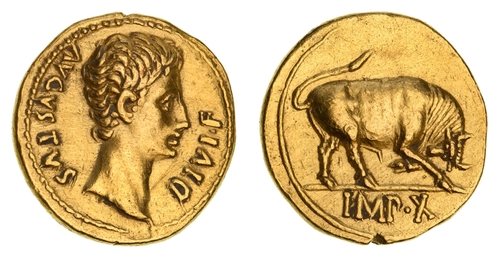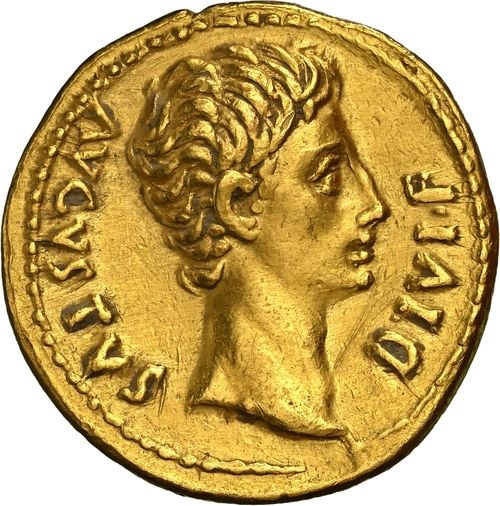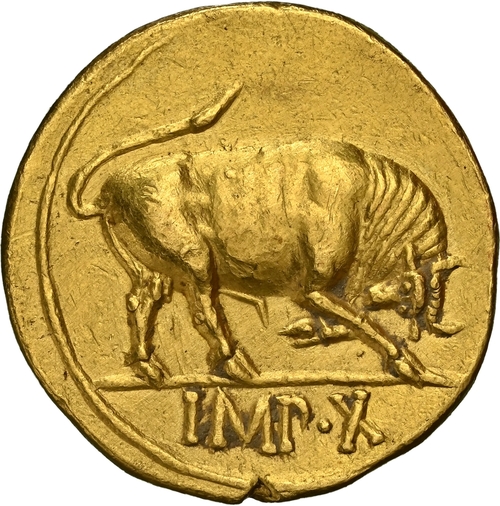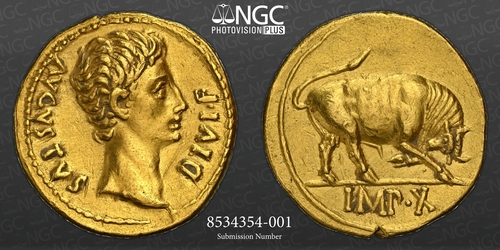Auction: 25055 - British Medals and World Coins featuring The Hurter-Amman Collection of Ancient and European Gold
Lot: 1091
NGC XF | Roman Empire, Augustus (27 BC - AD 14), AV Aureus, Lugdunum, struck 15-13 BC, Rome, AVGVSTVS DIVI F, bare head right, rev. Bull butting right, IMP X in exergue, 8.00g, 6h (Cohen 136; Bahrheldt 201; BMC 450; RIC I², 166a; Calicó 212), evidence of old cleaning particularly on the obverse probably to remove old illustration wax, otherwise a strong impression, with an especially detailed depiction of the Bull, about extremely fine, in NGC 'Ancients' holder, graded XF ~ Brushed (Cert. #8534354-001) [Strike: 5/5; Surface: 1/5]
Provenance
The "Hurter-Amman" Collection of Ancient and World Gold and Silver Coins and Medals
Messrs Spink & Son, by private treaty, 20 April 1938 - £17.10.0 [with this green stock ticket, ref. G7965 - £20.0.0]
Purchased from Giovannina Majer of Venice, Spring 1938
Giovannina Majer (1885-1966) was a prominent Italian numismatist based in Venice. Her father, Nicoló Majer (1855-1912) had worked for Giuseppe Morchio before selling coins under his own name from 1907, basing his business in San Lio.
Following her father's death in 1912, Giovannina took up the family business, dealing coins across Europe, with the Majer firm being bought out by the Banco Italiana di Sconto (Florence). She briefly ran the Bank's minting operations until it was liquidated in 1921.
After 1937, Giovannina worked as the numismatic consultant for the Museo Correr coin cabinet. As she was only contracted for 36 hours per month, Giovannina continued to deal coins while she oversaw the reorganisation of the Correr's numismatic collections, half of which had not yet been catalogued.
Giovannina was a prolific author of academic articles on the numismatics of modern Italy, some of which were featured in the Numismatic Circular, and a member of a selection of Italian and foreign numismatic associations. The Majer firm continued to produce fixed price lists until Giovannina's retirement in 1951.
Why did Augustus depict a bull on the reverse of this aureus? Like many first century BC issues, it is open to a variety of interpretations. Most obviously, the charging bull appears to be a near-identical copy of those found on the coinage of the Greek colony of Thurii, the only difference being in the raising of the left hoof rather than the right, as is common on the Greek coins. Thurii was recolonised by the Romans in 194 BC, briefly taking the name Copiae, to denote its fertile ager. In 40 BC, in the midst of the Bellum Sicilum (one of the wars fought by the Second Triumvirate), the town played an important role for future-emperor Octavian by repulsing Pompey. Augustus appears to offer similar commentaries on victorious battles with his Apollo of Actium and Diana of Sicily aurei.
The charging or butting bull was also used on the coinage of the Marsic Confederation during the Social Wars (91-88 BC), a conflict between Rome and her allies. In one issue, the bull, a representation of Italia, is depicted goring a she-wolf, the image of Rome. In fact, the very name Italia is etymologically connected to the Latin word for calf, vitulus (whence we get Italian 'vitello' and English 'veal'). Thus, the use of the bull as a representation of Italy was reclaimed from the enemies of Rome to symbolise the new Augustan order: an Empire ruled by Italy, not just by Rome.
Legitimising this new imperium further, there is also a link from the bull to Augustus' adoptive family, the Gens Iulia. This noble family was said to have been descended from Iulus, the son of Aeneas and grandson of Venus, whose astrological sign is, of course, the taurus. With this, Augustus had the perfect symbol of unity between Italy, his dynasty, and the gods.
https://www.ngccoin.uk/certlookup/8534354-001/NGCAncients/
Subject to 20% VAT on Buyer’s Premium. For more information please view Terms and Conditions for Buyers.
Sold for
£9,500
Starting price
£4000











